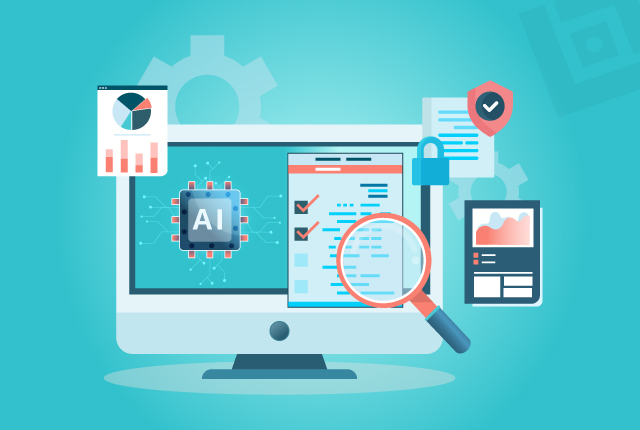
Recent studies indicate a reduction in test case generation time by up to 50% while expanding test coverage and accuracy. Additionally, organizations report up to a 25% decrease in overall testing costs due to optimizing resources and reducing manual efforts.
In this blog post, we will delve into the applications and impact of AI in software development. We aim to shed light on how development teams can leverage AI to improve quality assurance, optimize resources, and increase cost-effectiveness. We will examine the practical implementation of AI in functional testing and provide insights into its tangible benefits. We will draw on QASource's extensive expertise and experience in this field to do so.
The AI Difference in QA Functional Testing
AI in functional testing means increased efficiency and precision. Let's explore its impact.
- Automated Test Case Creation: AI streamlines the generation of test cases by analyzing requirements and historical data, ensuring exhaustive coverage while saving time.
- Pinpoint Accuracy: AI algorithms leverage past test outcomes to identify defect hotspots, sharpening the focus and effectiveness of testing efforts.
- Efficiency Upsurge: AI-driven tools outpace manual testing in speed and consistency, easily handling repetitive tasks. This shift allows human testers to concentrate on complex, exploratory testing.
- Cost Reduction: By automating routine tasks, AI slashes costs and expedites early defect detection, trimming late-stage bug-fixing expenses.
- Collaborative Synergy: Real-time AI insights bolster team collaboration, enhancing decision-making and prioritization in the testing process.
Navigating Functional Testing Challenges with AI
Functional testing presents several challenges that can be addressed with the help of AI:
- Overcoming Monotony: AI eradicates the tedium of repetitive testing, freeing testers to tackle more strategic tasks.
- Expanding Test Coverage: AI's capacity to generate diverse test cases ensures thorough coverage, a critical factor as software complexity escalates.
- Resource Optimization: AI minimizes resource demands, streamlining the allocation of time, manpower, and testing environments.
AI Techniques Elevating QA Functional Testing
Several AI methodologies are reshaping functional testing:
- Machine Learning: Enhances defect detection accuracy by analyzing historical data and identifying patterns.
- Natural Language Processing (NLP): Automates test case creation by interpreting requirements and specifications in human language.
- Computer Vision: Detects and analyzes visual elements, pinpointing interface issues that manual testing might overlook.
- Predictive Analytics: Uses historical data to forecast future issues, guiding focused testing efforts.
Why is AI Indispensable in QA Functional Testing?
Integrating AI into the process of QA functional testing offers numerous benefits that are hard to ignore.
- Optimized Resources: AI maximizes the use of available resources, ensuring cost-effectiveness and heightened efficiency.
- Intelligent Test Case Generation: AI's analytical prowess guarantees comprehensive test coverage and time savings.
- Enhanced Efficiency and Time Savings: AI's rapid test execution accelerates the software development lifecycle, leading to quicker market releases.
- Invaluable Insights: AI-driven analytics inform strategic decision-making, enhancing team collaboration and software quality.
- Self-healing Test Maintenance: AI aids in self-healing test maintenance by automatically updating test scripts according to object map changes in the application. This minimizes manual effort, crucial in agile setups with frequent codebase alterations.
Adopting AI in QA Functional Testing: Challenges and Considerations
The shift to AI-driven functional testing isn't without its challenges:
- Data Quality Imperative: AI requires high-quality data for accurate analysis, underscoring the need for robust data management.
- Domain Knowledge Necessity: AI models must be infused with domain-specific insights for peak performance.
- Complex Environment Management: Integrating AI into existing test environments demands careful planning and support.
- Collaboration and Expertise: A successful AI implementation requires a collaborative effort from diverse experts, including testers, developers, and data scientists.
Future Trends in AI-Driven QA Functional Testing
As AI technologies evolve, we can anticipate:
- Wider Adoption of AI Tools: Increased reliance on AI for efficient and effective functional testing.
- AI in CI/CD Pipelines: Seamless integration of AI in DevOps for automated, continuous testing.
- NLP and Machine Learning Advancements: More sophisticated algorithms for even greater test case creation and defect detection accuracy.
- Explainable AI: Enhanced transparency in AI decision-making for increased trust and reliability.
- Integration with Management Systems: Streamlined defect tracking and management for improved software quality.
Case Study: QASource's AI Integration
QASource's adoption of AI for test case generation exemplifies the power of AI in QA functional testing:
- 50% Reduction in Time: Marked decrease in test case generation duration.
- Improved Coverage and Accuracy: Enhanced test coverage, leading to superior software releases.
- Cost Savings: Notable reduction in manual effort and optimized resource use.
Conclusion
Integrating AI in QA functional testing marks a significant leap in software development, elevating testing processes' efficiency, accuracy, and scope. At QASource, our commitment to innovation and quality is reflected in our adoption of AI-driven testing strategies. While specific statistics on the impact of AI in QA functional testing vary, the general trend indicates substantial improvements in test coverage, error detection, and overall testing speed.
This technological advancement streamlines the testing process and ensures a higher quality of software products, ultimately benefiting both developers and end-users. As the landscape of software testing continues to evolve, QASource remains at the forefront, harnessing the power of AI to deliver superior testing solutions that meet the dynamic needs of our clients.



